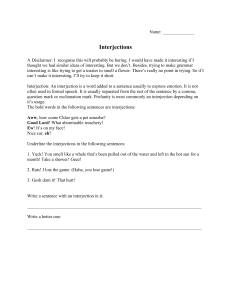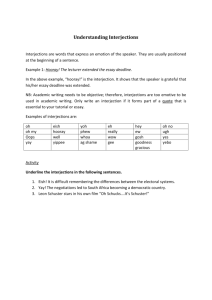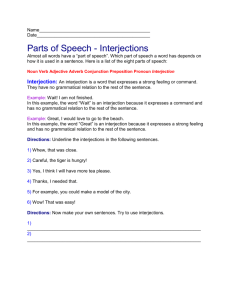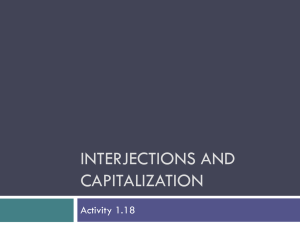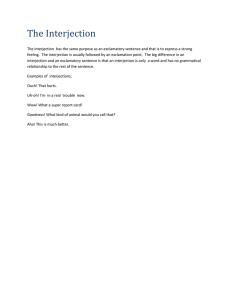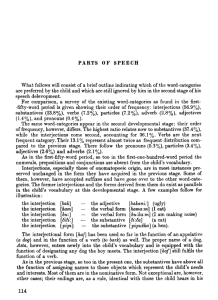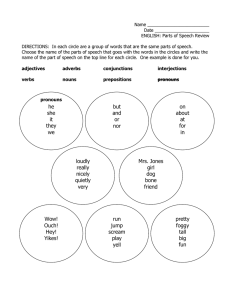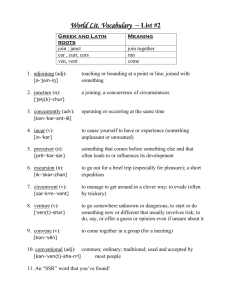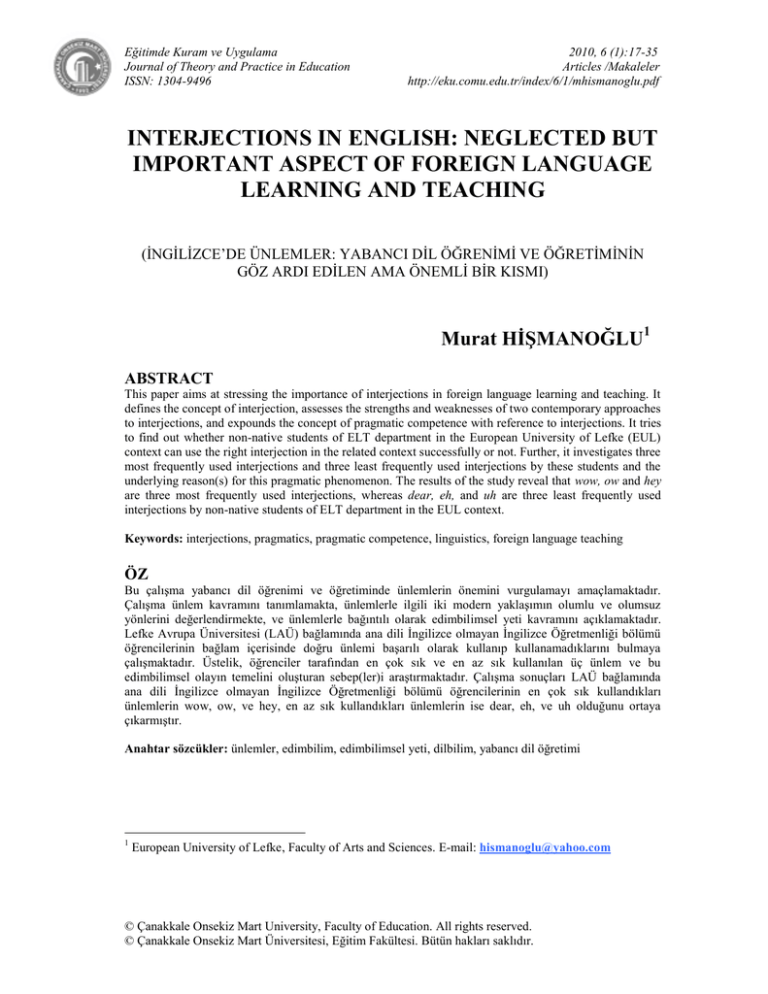
Eğitimde Kuram ve Uygulama
Journal of Theory and Practice in Education
ISSN: 1304-9496
2010, 6 (1):17-35
Articles /Makaleler
http://eku.comu.edu.tr/index/6/1/mhismanoglu.pdf
INTERJECTIONS IN ENGLISH: NEGLECTED BUT
IMPORTANT ASPECT OF FOREIGN LANGUAGE
LEARNING AND TEACHING
(ĠNGĠLĠZCE‟DE ÜNLEMLER: YABANCI DĠL ÖĞRENĠMĠ VE ÖĞRETĠMĠNĠN
GÖZ ARDI EDĠLEN AMA ÖNEMLĠ BĠR KISMI)
Murat HİŞMANOĞLU1
ABSTRACT
This paper aims at stressing the importance of interjections in foreign language learning and teaching. It
defines the concept of interjection, assesses the strengths and weaknesses of two contemporary approaches
to interjections, and expounds the concept of pragmatic competence with reference to interjections. It tries
to find out whether non-native students of ELT department in the European University of Lefke (EUL)
context can use the right interjection in the related context successfully or not. Further, it investigates three
most frequently used interjections and three least frequently used interjections by these students and the
underlying reason(s) for this pragmatic phenomenon. The results of the study reveal that wow, ow and hey
are three most frequently used interjections, whereas dear, eh, and uh are three least frequently used
interjections by non-native students of ELT department in the EUL context.
Keywords: interjections, pragmatics, pragmatic competence, linguistics, foreign language teaching
ÖZ
Bu çalışma yabancı dil öğrenimi ve öğretiminde ünlemlerin önemini vurgulamayı amaçlamaktadır.
Çalışma ünlem kavramını tanımlamakta, ünlemlerle ilgili iki modern yaklaşımın olumlu ve olumsuz
yönlerini değerlendirmekte, ve ünlemlerle bağıntılı olarak edimbilimsel yeti kavramını açıklamaktadır.
Lefke Avrupa Üniversitesi (LAÜ) bağlamında ana dili Ġngilizce olmayan Ġngilizce Öğretmenliği bölümü
öğrencilerinin bağlam içerisinde doğru ünlemi başarılı olarak kullanıp kullanamadıklarını bulmaya
çalışmaktadır. Üstelik, öğrenciler tarafından en çok sık ve en az sık kullanılan üç ünlem ve bu
edimbilimsel olayın temelini oluşturan sebep(ler)i araştırmaktadır. Çalışma sonuçları LAÜ bağlamında
ana dili Ġngilizce olmayan Ġngilizce Öğretmenliği bölümü öğrencilerinin en çok sık kullandıkları
ünlemlerin wow, ow, ve hey, en az sık kullandıkları ünlemlerin ise dear, eh, ve uh olduğunu ortaya
çıkarmıştır.
Anahtar sözcükler: ünlemler, edimbilim, edimbilimsel yeti, dilbilim, yabancı dil öğretimi
1
European University of Lefke, Faculty of Arts and Sciences. E-mail: hismanoglu@yahoo.com
© Çanakkale Onsekiz Mart University, Faculty of Education. All rights reserved.
© Çanakkale Onsekiz Mart Üniversitesi, Eğitim Fakültesi. Bütün hakları saklıdır.
Interjections in English: neglected but important aspect of
foreign language learning and teaching
INTRODUCTION
The term “interjection” arises from the Latin inter meaning “between” and
jacer meaning “throw”. They are words or constructions with no real linguistic
value but we generally employ them to express feelings or states of mind in daily
life situations. We use interjections more in speaking than in writing. Examples in
English include wow, ouch, oops, er, huh, gee, ooh, uh, aha, brrr, shh, ahem, psst
(Li, 2005:65).
The reason why we have focused on interjections in this paper is that the
teaching of interjections has long been ignored by language teachers working at
ELT departments in our country. Especially, in speaking lessons, language
teachers do not provide their students with semantic and pragmatic knowledge
regarding English interjections, which, unfortunately, gives rise to students‟ not
being able to establish a successful oral communication when interacting with
(non)native speakers of English beyond the classroom context. It defines the
concept of interjection, assesses the strengths and weaknesses of two
contemporary approaches to interjections, and expounds the concept of pragmatic
competence with reference to interjections. It tries to find out whether non-native
students of ELT department in the European University of Lefke (EUL) context
can use the right interjection in the related context successfully or not. Further, it
investigates three most frequently used interjections and three least frequently
used interjections by these students and the underlying reason(s) for this
pragmatic phenomenon.
INTERJECTIONS
Traditionally, interjections have often been regarded as peripheral to
language. Latin grammarians characterized them as non-words, unrelated to
syntax, expressing only feelings or states of mind. The linguists in the 19th
century viewed them as para-linguistic, even non-linguistic occurrences (Benfey
1869:295). Sapir (1970:7) categorized interjections as “never more, at best, than a
decorative edging to the ample, complex fabric of language".
Such views can still be encountered in contemporary literature: Quirk et al.
(1985:853) describe interjections as "purely emotive words which do not enter
into syntactic relations"; Trask (1993:144) describes an interjection as "a lexical
item or phrase which serves to express emotion and which typically fails to enter
into any syntactic structures at all"; Crystal (1995:207) defines an interjection as
"a word or sound thrown into a sentence to express some feeling of the mind".
Eğitimde Kuram ve Uygulama / Journal of Theory and Practice in Education
http://eku.comu.edu.tr/index/6/1/mhismanoglu.pdf
18
Hişmanoğlu
Eğitimde Kuram ve Uygulama
Journal of Theory and Practice in Education
2010, 6 (1):17-35
In what follows, the relative strengths and weaknesses of two contrasting
approaches to interjections, the sociolinguistic approach and the semantic
approach, will be assessed.
APPROACHES TO INTERJECTIONS
The sociolinguistic approach
Those who support the sociolinguistic approach contend that an interjection
“doesn‟t seem to be a statement in the linguistic sense”. Rather, it is a “ritualized
act, in something like the ethological sense of that term” (Goffman, 1981:100). In
sociolinguistic viewpoint, interjections are not part of language, and are analyzed
in relation to the socio-communicative roles they play, rather than any linguistic
content they are likely to have.
Goffman views interjections as "response cries": "We see such 'expressions'
as a natural overflowing, a flooding up of previously contained feeling, a bursting
of normal restraints" (1981:99). By "response cries", Goffman indicates
expressions such as ouch, oops, yuk, wow, eh, ah, oh, etc. He categories response
cries in terms of what function they serve. Some are indeed more or less
instinctive, normal reactions: the transition display, where a person articulating
brrr when leaving a warm atmosphere for a cold one might not only do so to
restore some sort of physical equilibrium but also to "fall into cadence with the
others in the room" (1981:101); the spill cry, where a person saying oops on
dropping something might do so in that it has the impact of "downplaying import
and hence implication as evidence of our incompetence" (1981:102).
In Goffman‟s viewpoint, the basic function of ouch (the pain cry) is to warn
others that a threshold for pain is being reached, or about to be breached. Because
such response cries (i.e. ouch, oops, ah) are not productive linguistically, they
cannot be regarded as part of language. In spite of regarding response cries as
peripheral to language proper, Goffman does not disregard their communicative
adaptability. He stresses that if being told by a friend about a specifically
gruesome moment from their previous trip to the dentist‟s, you might say ouch
sympathetically on their behalf. Or it might be used as in the following sentence:
(1) Dentist: That‟ll be £75 for the consultation and £30 for the cavity.
Patient: Ouch!
It is, after all, obvious that ouch and most primary interjections, while being
instinctive in some respects, are under our conscious control. If a person brings a
hammer down forcefully on his thumb, the four-letter word he says is unlikely to
commence with 'o'. A person screaming in agony is not screaming ouch. Thus, it
can be stated that interjections do have some kind of meaning in spite of their
© Çanakkale Onsekiz Mart University, Faculty of Education. All rights reserved.
© Çanakkale Onsekiz Mart Üniversitesi, Eğitim Fakültesi. Bütün hakları saklıdır.
19
Interjections in English: neglected but important aspect of
foreign language learning and teaching
expressive and instinctive nature. In the following section, we will look at what
interjections communicate besides the instinctive overflowing.
The semantic approach
The linguists who support the semantic approach argue that interjections are
“semantically rich and have a definite conceptual structure which can be
explicated” (Wilkins 1992:120). They stress that interjections communicate
complex conceptual structures, have real semantic content and communication is
achieved mainly via encoding conceptual structures. The following example
shows the kind of analysis proposed by the semanticists, Wierzbicka‟s conceptual
structure for wow (1992:163):
(2) wow!
I now know something
I wouldn‟t have thought I would know it
I think: it is very good
(I wouldn‟t have thought it could be like that)
I feel something because of that
As can be seen from this analysis, semantic analyses of interjections are
massively decompositional. Just as Wierzbicka states, "we can capture the
subtlest shades of meaning encoded in interjections relying exclusively on
universal or near-universal concepts, such as 'good' and 'bad', 'do' and 'happen',
'want', 'know', 'say', or 'think' (Wierzbicka 1992:163).
There are certain problems with this approach despite the emergence of a
number of analyses within this framework. Firstly, its experimental
psycholinguistic evidence exhibits that decompositional aspects of meaning are
devoid of psychological reality (Fodor, Fodor and Garrett, 1975).
The second problem with the semantic approach is that an utterance of wow
seems to communicate something altogether more obscure than the kind of
structures they propose would predict: as shown above, the meaning of wow
cannot be 'rigously defined'. This is not to deny that interjections can
communicate a great deal. However, the range of communicative effects an
utterance of wow might lead to, when integrated with different intonations and
facial expressions, seems to go well beyond anything capturable in semantic
structures such as those proposed above.
The third problem for the semantic approach is the context-dependence of
interjections. Of course, (2) is not a fully propositional structure because of
including uninterpreted indexicals (I, it, now), assigned reference by means other
Eğitimde Kuram ve Uygulama / Journal of Theory and Practice in Education
http://eku.comu.edu.tr/index/6/1/mhismanoglu.pdf
20
Hişmanoğlu
Eğitimde Kuram ve Uygulama
Journal of Theory and Practice in Education
2010, 6 (1):17-35
than linguistic decoding. To put it differently, the communicative content of
interjections is more obscure than the proposed conceptual structures would
predict. It is the highly context-dependent nature of interjections that suggests a
substantial pragmatic contribution to their comprehension.
The fourth problem with the approach is overlooking partly linguistic and
partly natural composition of interjections. As is known, interjections fall
somewhere between the natural and the linguistic. They share the feature of being
partly coded and partly natural with tone of voice, facial expressions and even
gestures. The fifth problem is related with the fact that interjections do not
contribute to the truth conditions of the utterances containing them. That is,
interjections are, in reality, non-truth-conditional. The non-truth-conditionality of
interjections suggests that a conceptual account is inappropriate, and that
alternative semantic treatments should be explored.
PRAGMATIC COMPETENCE
Language learners often have difficulty in communicating with other people
in the target language because of being communicatively incompetent. For this
reason, they need to have not only knowledge of vocabulary, morphology, syntax,
phonology, and the graphemic elements but also of the social and contextual
factors underlying the target language. These factors indicate the norms of
interaction shared by members of a given speech community to establish and
maintain successful communication. They are related to one of the basic
ingredients of the construct of communicative competence, that is, pragmatic
competence (Bachman, 1990:87).
Pragmatic competence includes both 'illocutionary competence' and
'sociolinguistic competence'. While illocutionary competence refers to the
functional use of language, sociolinguistic competence refers to the
appropriateness of an utterance to context. Illocutionary competence involves the
ability to (a) express ideas and emotions (ideational function), (b) get things done
(manipulative function), (c) use language to teach, learn, and solve problems
(heuristic function), and (d) be creative (imaginative function). Sociolinguistic
competence comprises a sensitivity to (a) dialect or variety, (b) register, (c)
naturalness (native-like use of language), and (d) cultural references and figures
of speech (Bachman, 1990:87-98). A lack of pragmatic competence on the part of
language learners may result in undesirable misunderstandings which can give
rise to a breakdown of communication. Hence, language learners should be made
familiar with how to behave appropriately when employing a variety of pragmatic
features if their goal is to communicate successfully in the target language and
culture.
© Çanakkale Onsekiz Mart University, Faculty of Education. All rights reserved.
© Çanakkale Onsekiz Mart Üniversitesi, Eğitim Fakültesi. Bütün hakları saklıdır.
21
Interjections in English: neglected but important aspect of
foreign language learning and teaching
When teaching commonly used English interjections to non-native students,
the language teacher should try to make students aware of a wide variety of
functions expressed by interjections in the English language and emphasize the
importance of using interjections in the most appropriate context. S/he should
stress that the functions expressed by interjections are typically emotional, such
as pleasure, surprise, pity, hesitation, greeting, pain, pleading, etc. The following
table exhibits some of the common interjections and their communicative
functions (Essberger, 2009).
Table 1. Common Interjections in English and their Communicative
Functions
Interjection
Ah
Dear
Eh
Er
hello, hullo
Hey
Hi
Hmm
Oh, o
Ouch
Uh
Uh-huh
Um, umm
Well
Communicative Function
Example
expressing pleasure
"Ah, that feels good."
expressing realization
"Ah, now I understand."
expressing resignation
"Ah well, it can't be hoped."
expressing surprise
"Ah! I've won!"
expressing pity
"Oh dear! Does it hurt?"
expressing surprise
"Dear me! That's a surprise!"
asking for repetition
"It's hot today." "Eh?"
"I said it's hot today."
expressing enquiry
"What do you think of that, eh?"
expressing surprise
"Eh! Really?"
inviting agreement
"Let's go, eh?"
expressing hesitation
"Lima is the capital of...er...Peru."
expressing greeting
"Hello John. How are you today?"
expressing surprise
"Hello! My car's gone!"
calling attention
"Hey! look at that!"
expressing surprise, joy etc
"Hey! What a good idea!"
expressing greeting
"Hi! What's new?"
expressing hesitation, doubt
"Hmm. I'm not so sure."
or disagreement
expressing surprise
"Oh! You're here!"
expressing pain
"Oh! I've got a toothache."
expressing pleading
"Oh, please say 'yes'!"
expressing pain
"Ouch! That hurts!"
expressing hesitation
"Uh...I don't know the answer to that."
expressing agreement
"Shall we go?" "Uh-huh."
expressing hesitation
"85 divided by 5 is...um...17."
expressing surprise
"Well I never!"
introducing a question
"Well, what did he say?"
As is clearly seen in the above table, the interjections and their
communicative functions are English language specific, that is, non-native
learners, especially those in an EFL context like Turkey, may have difficulty in
understanding the functions of English interjections and using them in a suitable
Eğitimde Kuram ve Uygulama / Journal of Theory and Practice in Education
http://eku.comu.edu.tr/index/6/1/mhismanoglu.pdf
22
Hişmanoğlu
Eğitimde Kuram ve Uygulama
Journal of Theory and Practice in Education
2010, 6 (1):17-35
context because of not having access to authentic input of the target speech
community.
METHOD AND ANALYSIS OF THE DATA
Method and subjects
41 non-native first year students at European University of Lefke, Faculty of
Arts and Science, Department of English Language Teaching and 7 native
teachers of English at EUL Preparatory School participated in this study. Most of
the students were at the age of 20 though some of them were 21 or 22. The
number of female students was higher that of male students as seen in the graphic
below.
Sex and age distribution of the learners surveyed
16
15
14
14
Age 20 (Male)
12
12
12
Age 20 (Total)
10
10
Age 21 (Male)
8
7
6
4
Age 20 (Female)
5
4
Age 21 (Female)
Age 21 (Total)
Age 22 (Male)
3
2
Age 22 (Female)
0
Age 22 (Total)
1
Graphic 1. Sex And Age Distribution of the Learners Surveyed
© Çanakkale Onsekiz Mart University, Faculty of Education. All rights reserved.
© Çanakkale Onsekiz Mart Üniversitesi, Eğitim Fakültesi. Bütün hakları saklıdır.
23
Interjections in English: neglected but important aspect of
foreign language learning and teaching
As for the native teachers of English, it can be stated that their ages ranged
from 35 to 49. The number of male teachers was 2, whereas the number of female
teachers was 5.
These students are the students of a four-year teacher-training program at
European University of Lefke. Their mother tongue is Turkish and they are
required to have a certain level of proficiency in English to be able to start the
first year. Before starting the first year, these students take a proficiency test at
the beginning of the academic year. In this proficiency test, their reading, writing,
speaking, and grammar abilities are tested. Those achieving the required level of
proficiency start with the first year; however, those performing below the
required level of proficiency attend a one-year preparatory program, and they take
another proficiency test to continue with the first year at the end of the
preparatory program.
These 41 students were all beyond a certain level of proficiency – which is
upper-intermediate – and had all taken and succeeded in the compulsory speaking
course (ELT 175 Oral Communication Skills I) in the Fall Semester of the 1st
year program of the related department. However, they had difficulty in using
common interjections in English. They had no pragmatic knowledge regarding
the communicative functions of common interjections in English. The researcher
himself observed the pragmatic failure faced by 1st year students in relation to the
use of English interjections, while lecturing them in a course like ELT 171
Contextual Grammar I in the Fall Semester of 2008- 2009 Academic Year.
Problem
Interjections have always been disregarded in foreign language teaching by
foreign language teachers. Especially, in speaking lessons, language teachers do
not provide their students with semantic and pragmatic knowledge regarding
English interjections, which, unfortunately, gives rise to students‟ having
difficulty in reflecting their emotions with target language specific emotive
words.
Because students are heavily under the influence of their mother tongue, they
have tendency to express their emotions with reference to common interjections
in the Turkish language. For instance, in English, the interjection Ouch has the
meaning of "pain". However, Turkish students of English tend to use Ah instead
of Ouch with the meaning of "pain".
Students do not live in a natural context where they can have the opportunity
to interact with native speakers of the target language, which not only decreases
their motivation to learn the target language but also negatively affects their
mastering communicative functions of the emotive words in English. To put it
Eğitimde Kuram ve Uygulama / Journal of Theory and Practice in Education
http://eku.comu.edu.tr/index/6/1/mhismanoglu.pdf
24
Hişmanoğlu
Eğitimde Kuram ve Uygulama
Journal of Theory and Practice in Education
2010, 6 (1):17-35
differently, it is the lack of the authentic context which makes learning the
communicative functions of English interjections difficult for Turkish learners of
English.
Instruments
Since this research aims to find out whether Turkish learners of English can
make use of the right interjection in the related context successfully, the
researcher designed a questionnaire consisting of 15 sentences to be used to elicit
the pragmatic knowledge of the subjects regarding common interjections in
English. When designing the questionnaire, the researcher not only collaborated
with a native speaker of English but also had a control group of native English
speaking respondents. By the help of the native speakers of English, the
researcher incorporated the interjections commonly used in contemporary English
into the questionnaire. However, the interjections that are highly stylized, quite
literary, and antiquated were excluded from the questionnaire. All native speakers
stressed that there was only one correct answer for each question in the
questionnaire. The following table shows the case clearly:
Table 2. Correct Use and Misuse Percentages of the Subjects in the
Control Group in Relation to Twelve Common English Interjections
Item Number
Interjection
Frequency
Correct Use
(%)
1
Dear
7
2
Oh
7
3
Hey
7
4
Ouch
7
5
Er
7
6
Wow
7
7
Dear
7
8
Uh
7
9
Hey
7
10
Yeah
7
11
Oh
7
12
Uh-huh
7
13
Ow
7
14
Eh
7
15
Well
7
* Out of 7 native English speaking respondents
100
100
100
100
100
100
100
100
100
100
100
100
100
100
100
Misuse
Frequency (%)
0
0
0
0
0
0
0
0
0
0
0
0
0
0
0
0
0
0
0
0
0
0
0
0
0
0
0
0
0
0
This questionnaire was chosen as data collection instrument due to the
following reasons:
© Çanakkale Onsekiz Mart University, Faculty of Education. All rights reserved.
© Çanakkale Onsekiz Mart Üniversitesi, Eğitim Fakültesi. Bütün hakları saklıdır.
25
Interjections in English: neglected but important aspect of
foreign language learning and teaching
1. It consists of sentences put into a real life like context.
2. It includes the most commonly used English interjections in various
positions in sentences in a meaningful context.
3. It offers communicative functions of English interjections.
4. It also fits the needs of the researcher aiming to find out whether the
subjects are under the negative influence of their mother tongue when using
interjections to communicate certain emotions.
Data collection procedures
After selecting the data collection instrument, the researcher obtained the
necessary permission from the head of the Department to conduct the research.
Following this procedure, the researcher gave the questionnaire to the students of
the 1st year in the Spring Semester of 2008-2009 Academic Year. In the
questionnaire, the subjects were asked to choose the best interjection for the gaps
in contextualized sentences. The subjects were told not to panic but to relax prior
to the administration of the questionnaire by the researcher. There was a friendly,
stress-free atmosphere in the language classroom. Students were asked not to
make a disturbing noise during the process in order not to harm the performance
of their classmates. The subjects submitted their questionnaire to the researcher
after they finished placing the best interjection into the relevant gap. After the
administration of the questionnaire, the scores were analyzed.
Data analysis procedures
After collecting the data at the beginning of the Spring Semester of
20082009 Academic Year, the researcher began to evaluate each paper by counting (a)
interjections used correctly, (b) interjections used incorrectly, and (c) interjections
that are not used (ignored by the subjects), and for scoring purpose, he gave one
point for each correct use. Incorrect use and those ignored by the subjects were
not taken into consideration. As a following step, the sum of the correct use for
each item was divided into the number of subjects participating in the research to
find out the frequency of correct use of interjections as the test performance of the
subjects for the related interjection in English. Thus, the researcher determined
problem causing English interjections for Turks through concrete proofs.
Analysis of the data
The researcher calculated the average correct use percentages for each
interjection in the experimental group. The following example shows the case
clearly:
Eğitimde Kuram ve Uygulama / Journal of Theory and Practice in Education
http://eku.comu.edu.tr/index/6/1/mhismanoglu.pdf
26
Hişmanoğlu
Eğitimde Kuram ve Uygulama
Journal of Theory and Practice in Education
2010, 6 (1):17-35
Table 3. Correct Use and Misuse Percentages of the Subjects in the
Experimental Group in Relation to Twelve Common English Interjections
Item Number
Interjection
Frequency
1
Dear
2
Oh
3
Hey
4
Ouch
5
Er
6
Wow
7
Dear
8
Uh
9
Hey
10
Yeah
11
Oh
12
Uh-huh
13
Ow
14
Eh
15
Well
* Out of 41 students
Correct Use
(%)
4
15
32
16
22
38
31
12
22
26
17
23
34
9
21
10
37
78
39
54
93
76
29
54
63
41
56
83
22
51
Misuse
Frequency (%)
37
26
9
25
19
3
10
29
19
15
24
18
7
32
20
90
63
22
61
46
7
24
71
46
37
59
44
17
78
49
Thus, he determined problem causing interjections for non-native first year
students of the ELT department. Graphic 2 shows the total correct use and misuse
percentages of twelve common English interjections.
Total correct use and misuse
percentages of twelve common
English interjections
52
52
50
48
48
46
1
Total correct use
Total misuse
Graphic 2. Total Correct Use and Misuse Percentages of Twelve
common English interjections
© Çanakkale Onsekiz Mart University, Faculty of Education. All rights reserved.
© Çanakkale Onsekiz Mart Üniversitesi, Eğitim Fakültesi. Bütün hakları saklıdır.
27
Interjections in English: neglected but important aspect of
foreign language learning and teaching
In the following, three most frequently used interjections, Wow, Ow and Hey
and three least frequently used interjections, Dear, Eh, and Uh in Table 1 will be
discussed in detail. The pragmatic discussions given here are based on Güneş
(2004), Turkish Dictionary (2008), Oxford Student‟s Dictionary (2007), and
Longman Dictionary (2003).
Three most frequently used interjections by non-native students of ELT
department
The use of the interjection wow in the related context
Of 41 students, 38 students (93 %) used the interjection wow in the related
context successfully. In English, the interjection wow is used for saying that you
are very impressed and surprised by something as seen in the example "Wow!
Look at that!" (Longman Dictionary, 2003:1909). Similarly, in Turkish, the
interjection vay is used to express the meaning of surprise as seen in the example
“Vay gülüm! Nereden bu geliş?” (Wow, my honey, where are you coming
from?). However, it should be stated that, unlike the use of wow in English, the
interjection vay in Turkish is also used to express the meaning of pain as seen in
the example "Vay başım" (Ow, I have a headache.) (Turkish Dictionary, 2008).
The reason why many subjects in the experimental group used the interjection
wow in the given context successfully is that English interjection wow is similar
to Turkish interjection vay in terms of not only sound but also meaning.
The use of the interjection ow in the related context
Of 41 students, 34 students (83 %) used the interjection ow in the related
context successfully. In English, the interjection ow is employed to express the
meaning of sudden pain as seen in the example "Ow, that hurts!" (Longman
Dictionary, 2003:1179). Similarly, in Turkish, the interjection of is employed to
express the same meaning as seen in the example "Of, kolum acıdı!" (Ow! I have
an arm ache). However, it should be stressed that the interjection of is also used to
refer to the meaning of boredom in Turkish as seen in the example "Of, bıktım
artık!" (I am fed up with it!) (Turkish Dictionary, 2008). The reason why the
subjects in the experimental group used English interjection ow correctly in the
given context is that they made use of contextual clues in the given sentence.
The use of the interjection hey in the related context
Of 41 students, 32 students (78 %) used the interjection hey in the given
context successfully. In both English and Turkish, the interjection hey is
employed to get someone's attention or to show surprise, interest, or annoyance as
seen in the example "Hey, wait a minute!" (Hey, bir dakika bekle!). However, it
Eğitimde Kuram ve Uygulama / Journal of Theory and Practice in Education
http://eku.comu.edu.tr/index/6/1/mhismanoglu.pdf
28
Hişmanoğlu
Eğitimde Kuram ve Uygulama
Journal of Theory and Practice in Education
2010, 6 (1):17-35
should be stated that, unlike the case in English, the interjection hey in Turkish
also refers to the meaning of reproach, complaining, scolding, admiration as seen
in the examples, such as "Hey talih, böyle mi olacaktı!" (Back luck. I did not
expect things to develop this way!), "Hey akılsız çocuk, ateşi niye ellersin?"
(Silly boy, why are you playing with the fire?), "Hey Allahım, bu ne güzellik!"
(Oh my God! How beautiful she is!) (Turkish Dictionary, 2008). The reason why
the subjects in the experimental group used the English interjection hey correctly
in the given context is that the same interjection exists in the Turkish language
with the same meaning.
Three least frequently used interjections by non-native students of ELT
department
The use of the interjection dear in the related context
Of 41 students, 4 students (10 %) used the interjection dear in the related
context successfully. In English, the interjection dear is used for expressing
disappointment, sadness, and surprise as seen in the example "Dear me! Aren't
you ready? ". It is also used when speaking to somebody you know well as seen
in the example "Would you like a cup of tea, dear? " (Oxford Student‟s
Dictionary, 2007). In Turkish, however, the word canım is used to express the
meaning of dissatisfaction and boredom as seen in the example "Canım be
evladım, bırak şu el öpmeyi" (My dear son! Stop hand kissing). The same word
can also be used when speaking to somebody you know well as seen in the
example "Canım, bir parça kek ister misin?" (Dear me! Would you like a piece of
cake?) (Turkish Dictionary, 2008). The reason why many subjects could not use
this interjection in the given context successfully is that Turkish learners of
English are under the influence of the linguistic system of their mother tongue,
Turkish. The same reason is also valid for the interjections eh and uh, analyzed
below.
The use of the interjection eh in the related context
Of 41 students, 9 students (22 %) used the interjection eh in the related
context successfully. In English, the interjection eh is used for asking somebody
to agree with you or repeat something as seen in the examples, such as „Good
party, eh?‟ (asking somebody to agree with you), „Did you like the film?‟ „Eh?‟ „I
asked if you liked the film!‟ (asking somebody to repeat something) (Oxford
Student‟s Dictionary, 2007). In Turkish, however, the same interjection refers to
the meaning of all right, OK, not bad, or dissatisfaction as seen in the examples,
such as „-Gidelim mi?‟ „Eh, haydi gidelim‟. (Shall we go? OK, let‟s go.) (All
© Çanakkale Onsekiz Mart University, Faculty of Education. All rights reserved.
© Çanakkale Onsekiz Mart Üniversitesi, Eğitim Fakültesi. Bütün hakları saklıdır.
29
Interjections in English: neglected but important aspect of
foreign language learning and teaching
right, OK), „-Nasılsınız?‟ „-Eh, şöyle böyle‟. (How are you? Not bad.) (Not bad),
„Eh, artık çok oluyorsun?‟ (I am dissatisfied with your behaviors)
(Dissatisfaction) (Turkish Dictionary, 2008).
The use of the interjection uh in the related context
Of 41 students, 12 students (29 %) used the interjection uh in the related
context successfully. In English, the interjection uh is used to refer to the meaning
of hesitation and it is also a space filler during conversation as seen in the
examples "Uh, I don‟t know how to solve this problem", "Uh, who was that?",
"Uh, let me see" (Oxford Student‟s Dictionary, 2007). In Turkish, however, the
interjection aaa is used to express the same meaning as seen in the example "Aaa,
en yakın bankanın nerede olduğunu bilmiyorum." (Uh, I don‟t know where the
nearest bank is). It should also be stressed that the interjection Aaa in Turkish,
unlike the use of the interjection uh in English, is used to refer to the meaning of
surprise and admiration as seen in the examples, such as "Aaa! Gel Sedat, başımla
beraber…" (Oh! Come Sedat, I will try my best for you.), "Aaa, doğrusu Tanrı
razı olsun, iyi adamlar" (Oh! To tell the truth, they are good people) (Güneş,
2004:303).
CONCLUSION AND RECOMMENDATIONS FOR LANGUAGE
TEACHERS
Interjections play a vital role in communicating emotions in real life
situations. However, the teaching of interjections has been disregarded by
language teachers in our country. Firstly, there are very few pedagogically
developed materials that can be used by teachers in the classroom context to teach
the communicative functions expressed by English interjections. Secondly, there
is a lack of preparation in relation to communicative teaching of interjections in
TESL/TEFL programs. Thirdly, language teachers, especially non-native ones,
lack the necessary pragmatic knowledge and education relevant to the pragmatics
of interjections in English.
There are ways in which language teachers in Turkey can help the students to
develop their pragmatic competence. The language teacher can raise the students‟
pragmatic awareness in relation to English interjections by having them watch
videos of authentic interaction and feature films. This way, the students can
become familiar with under what circumstances native speakers express surprise,
what interjection(s) they employ to express surprise, and to whom.
Whether gathered via out-of-class observation or brought into the classroom
via audiovisual media, authentic native speaker input is an important part of
Eğitimde Kuram ve Uygulama / Journal of Theory and Practice in Education
http://eku.comu.edu.tr/index/6/1/mhismanoglu.pdf
30
Hişmanoğlu
Eğitimde Kuram ve Uygulama
Journal of Theory and Practice in Education
2010, 6 (1):17-35
pragmatic learning. The language teacher should attribute importance to expose
the students to authentic native speaker input. This is not because the students
should imitate native speakers' action patterns but in order to construct their own
pragmatic knowledge based on the right kind of input (Kasper, 1997:10).
In the language classroom, the language teacher should try to give
interpersonal communication tasks to the students in that interpersonal
communication tasks are more concerned with participants' social relationships
and involve communicative acts. Students become involved in different social
roles and speech events through the inclusion of activities, such as role play,
simulation, and drama into the classroom. It is through these activities that the
language teacher can give the students the chance to practice the wide range of
pragmatic and sociolinguistic abilities (Crookall & Saunders, 1989; Crookall &
Oxford, 1990; Olshtain & Cohen, 1991) that they may need in interpersonal
encounters beyond the classroom context.
To illustrate, the language teacher may give the students funny scenarios to
act out by using only interjections as the dialogue. The teacher lets them practice
away from other groups and then perform for the class. After that, s/he lets the
class try to figure out what is going on. Look at the funny scenarios to be
performed for the class:
"Ouch!"
"Hmm!"
"Hey!"
"Oh!"
"Ah!"
(meaning: That hurts!)
(meaning: I am not so sure.)
(meaning: Look at that!)
(meaning: Please, say yes.)
(meaning: Now I understand.)
Another example is that the language teacher may present some
communicative situations that the students are likely to encounter in real life
situations beyond the classroom context and asks them to show reaction to these
situations as naturally as they can. Look at the communicative situations below
and the expected reactions written in parentheses:
You got 10 points at the IELTS exam. (expected reaction: Wow!).
Your little son is making a lot of noise and you want to watch the news on the
TV.
(expected reaction: Shh!)
Somebody has just stepped on your toe. (expected reaction: Ouch!)
You are vegetarian and you are offered a dish of raw meat (expected
reaction: Ugh!)
© Çanakkale Onsekiz Mart University, Faculty of Education. All rights reserved.
© Çanakkale Onsekiz Mart Üniversitesi, Eğitim Fakültesi. Bütün hakları saklıdır.
31
Interjections in English: neglected but important aspect of
foreign language learning and teaching
Finally, it should be underlined that L2 specific pragmatic development is
crucial to be effective and powerful communicators in the target language and
that pragmatic education should begin at the very beginning of foreign language
learning since pragmatic development is just as much a significant component of
language development as phonological, morphological, and syntactic
improvement. In an attempt to employ more complicated structures, advanced
learners with no L2 pragmatics specific education can apply to their L1
(Takahashi et al., 1987). Therefore, L2 pragmatics specific education can be said
to be a necessary complement rather than a supplement that needs to commence
even at the initial stages of foreign language learning (Yoshida, Kamiya, Kondo,
& Tokiwa, 2000). Only then can we make our students sensitive to the
importance of behaving in an appropriate way when utilizing a variety of
pragmatic features and successful in communicating with the native speakers of
the target language in real life situations.
REFERENCES
Benfey, T. (1869). Geschichte der Sprachwissenschaft. München: J.G. Cotta.
Crookall, D., & Oxford, R. (Eds.). (1990). Simulation, gaming, and language
learning. New York: Newbury House.
Crookall, D., & Saunders, D. (Eds.) (1988). Communication and simulation.
Clevedon: Multilingual Matters.
Crystal, D. (1995). The Cambridge Encyclopedia of Linguistics. Cambridge:
CUP.
Essberger, J. (2009). Interjections. Retrieved February 10, 2009 from
http://www.englishclub.com/grammar/interjections.htm.
Fodor, J., Fodor J., & Garrett, M. (1975). The psychological unreality of semantic
representations. Linguistic Inquiry, Fall: 515-531.
Goffman, E. (1981). Forms of Talk. Oxford: Blackwell.
Güneş, S. (2004). Türk Dilbilgisi. Ġzmir: Çağlayan Matbaası.
Kasper, Gabriel. (1997). Can pragmatic competence be taught? Retrieved March
15, 2009 from http://www.nflrc.hawaii.edu/NetWorks/NW06/default.html.
Li, Conghe. (2005). A cognitive-pragmatic account of interjections. US-China
Foreign Language, 3(9), 65-70.
Longman Dictionary of Contemporary English.(2003). Essex: Pearson Longman.
Eğitimde Kuram ve Uygulama / Journal of Theory and Practice in Education
http://eku.comu.edu.tr/index/6/1/mhismanoglu.pdf
32
Hişmanoğlu
Eğitimde Kuram ve Uygulama
Journal of Theory and Practice in Education
2010, 6 (1):17-35
Olshtain, E., & Cohen, A.D. (1991). Teaching speech act behavior to nonnative
speakers. In M. Celce-Murcia (Ed.), Teaching English as a second or
foreign language (154-165). Boston, MA: Heinle& Heinle.
Oxford Student’s Dictionary. (2007). Oxford: OUP.
Quirk, R., S. Greenbaum, J. Leech & J. Svartvik (eds.). (1985). A comprehensive
grammar of the english language. London: Longman
Sapir, E. (1970). Language. London: Hart-Davis.
Takahashi, T. & Beebe L.M. (1987). The development of pragmatic competence
by Japanese learners of English. JALT Journal, 8, 131-155.
Trask, R.L. (1993). A Dictionary of Grammatical Terms in Linguistics. London:
Routledge.
Turkish Dictionary. (2008). Retrieved March 10, 2009, from http://www.
tdkterim.gov.tr/bts/.
Yoshida, K., Kamiya, M., Kondo, S.& Tokiwa, R. (2000). Heart to heart:
Overcoming barriers in cross-cultural communication. Tokyo: Macmillan
Language House.
Wierzbicka, A. (1992). The semantics of interjection. Journal of Pragmatics,18,
159-192.
Wilkins, D. (1992). Interjections as deictics. Journal of Pragmatics,18, 119-158.
© Çanakkale Onsekiz Mart University, Faculty of Education. All rights reserved.
© Çanakkale Onsekiz Mart Üniversitesi, Eğitim Fakültesi. Bütün hakları saklıdır.
33
Interjections in English: neglected but important aspect of
foreign language learning and teaching
APPENDICES
A. Answers of the subjects in the control group to the questionnaire
St
1
2
3
4
5
6
7
1
D
D
D
D
D
D
D
2
D
D
D
D
D
D
D
3
A
A
A
A
A
A
A
4
C
C
C
C
C
C
C
5
B
B
B
B
B
B
B
6
A
A
A
A
A
A
A
7
C
C
C
C
C
C
C
8
A
A
A
A
A
A
A
9
A
A
A
A
A
A
A
10
A
A
A
A
A
A
A
11
B
B
B
B
B
B
B
12
C
C
C
C
C
C
C
13
C
C
C
C
C
C
C
14
A
A
A
A
A
A
A
15
D
D
D
D
D
D
D
B. Answers of the subjects in the experimental group to the questionnaire
St
1
2
3
4
5
6
7
8
9
10
11
12
13
14
15
16
17
18
19
20
21
22
23
24
25
26
27
28
29
30
31
32
33
34
1
C
C
C
B
B
B
B
B
B
C
B
B
D
C
D
B
B
B
B
B
C
D
C
B
A
B
B
C
B
B
B
D
C
C
2
D
C
D
B
C
B
A
C
D
D
D
B
D
B
D
B
B
B
B
D
D
B
A
D
B
C
D
B
B
B
B
D
B
D
3
A
B
B
A
A
B
B
A
B
B
A
A
A
A
A
A
A
B
A
A
A
A
A
A
A
D
A
A
A
A
A
A
A
D
4
C
B
B
B
C
B
A
B
B
D
A
B
C
C
C
B
B
C
B
C
B
C
B
C
C
B
B
B
D
D
C
C
B
C
5
A
A
C
D
A
B
A
B
C
C
B
B
A
B
A
B
B
B
B
B
B
B
B
B
C
C
C
C
C
B
C
A
B
B
6
D
A
A
A
A
A
A
A
A
A
A
A
A
A
A
A
A
A
A
A
A
A
A
A
A
A
A
A
A
A
C
D
A
A
7
A
A
A
C
D
D
C
C
C
C
D
C
D
C
C
C
C
C
C
A
C
C
C
D
C
C
C
C
C
C
C
C
C
C
8
B
B
B
B
B
C
D
D
A
B
C
A
B
C
B
C
A
C
C
A
B
B
C
B
B
C
A
A
A
D
C
D
A
B
9
B
C
C
D
C
B
A
D
B
C
D
A
D
C
A
A
A
A
A
A
B
D
A
A
A
D
B
A
D
A
A
B
A
B
10
A
D
B
B
A
A
C
A
A
A
A
A
C
D
C
A
A
A
A
D
A
A
B
B
A
A
A
C
A
A
C
D
A
A
11
C
D
D
B
D
B
A
B
A
D
B
D
D
A
D
D
D
B
D
B
D
D
A
C
B
C
B
A
B
A
B
C
B
D
Eğitimde Kuram ve Uygulama / Journal of Theory and Practice in Education
http://eku.comu.edu.tr/index/6/1/mhismanoglu.pdf
12
C
C
C
B
B
A
C
C
B
D
D
A
A
C
B
C
B
B
D
C
B
A
C
C
A
C
B
C
C
C
C
C
D
C
13
A
C
C
A
C
C
C
C
A
C
B
C
C
C
C
C
C
B
C
C
C
C
C
C
C
C
C
C
C
C
C
C
C
C
14
C
D
B
D
B
A
C
D
A
B
D
B
A
D
B
B
B
B
C
B
D
C
D
C
D
A
B
A
B
D
A
D
D
D
15
A
B
A
D
B
B
D
D
C
D
D
D
A
D
A
A
B
A
D
A
D
D
D
D
D
C
D
D
C
D
B
D
B
D
34
Hişmanoğlu
35
36
37
38
39
40
41
A
B
B
C
B
B
C
B
D
B
D
B
B
B
Eğitimde Kuram ve Uygulama
Journal of Theory and Practice in Education
2010, 6 (1):17-35
A
A
A
A
A
A
A
C
B
B
C
B
C
B
C
B
B
C
B
B
B
A
A
A
A
A
A
A
C
C
C
B
C
C
C
A
B
A
A
A
B
C
A
A
A
A
A
A
A
A
A
C
A
C
A
A
B
B
B
B
B
B
D
C
D
C
D
C
C
C
B
C
C
C
A
C
C
D
D
A
B
A
C
A
C
C
A
D
D
B
D
C. Questionnaire
Participant Details
Name of the University: ..............................................
Age: ................ Sex: ................
( ) Native speaker of English
( ) Non-native speaker of English
Dear Participants,
This questionnaire aims to find out whether you are aware of commonly used English interjections and
whether you can use them in the related context.
Please note that your answers will be kept confidential
1) “______ me! That‟s a surprise!” (expressing surprise)
a) Er
b) Ouch c) Hey
d) Dear
2) “____, please say 'yes' !” (expressing pleading)
a) Er
b) Ah
c) Eh
d) Oh
3) “_____ Ted. How are you today?” (expressing greeting)
a) Hey
b) Yeah c) Er
d) Ah
4) “______! You‟re stepping on my foot.” (expressing pain)
a) Eh
b) Oh
c) Ouch d) Well
5) “Dhaka is the capital city of ______ Bangladesh.” (expressing hesitation)
a) oh
b) er
c) eh
d) hey
6) “____! What a good idea!” (expressing surprise, joy, etc.)
a) Wow b) Eh
c) Ouch d) Er
7) “Oh ____! Does it hurt?” (expressing pity)
a) hey
b) er
c) dear
d) eh
8) “____... I don‟t know the answer to that.” (expressing hesitation)
a) Uh
b) Oh
c ) Ah
d) Ow
9) “____! look at that!” (calling attention)
a) Hey
b) Ye
c) Yeah d) Oh
10) “_____, that seems good.” (expressing pleasure)
a) Yeah b) Er
c) Hey
d) Ow
11) “_____! You‟re here!” (expressing surprise)
a) Uh
b) Oh
c) Er
d) Hey
12) “Shall we go?” “_____.” (expressing agreement)
a) Er
b) Hey
c) Uh-huh
d) Ow
13) “____! I‟ve got a toothache.” (expressing pain)
a) Hmm b) Eh
c) Ow
d) Er
14) “What do you think of that, ____?” (expressing enquiry)
a) eh
b) ah
c) oh
d) ow
15) “______, what did he say?” (introducing a question)
a) Ah
b) Uh
c) Ouch d) Well
Thank you for your participation. Dr. Murat Hismanoglu
© Çanakkale Onsekiz Mart University, Faculty of Education. All rights reserved.
© Çanakkale Onsekiz Mart Üniversitesi, Eğitim Fakültesi. Bütün hakları saklıdır.
35

